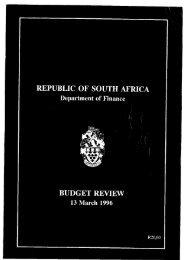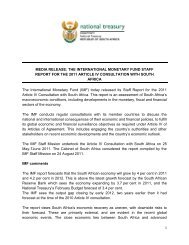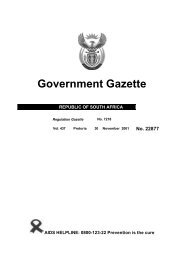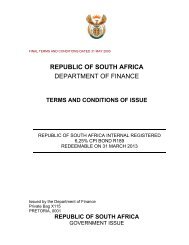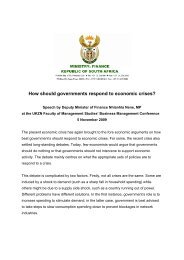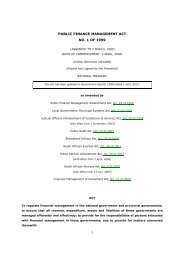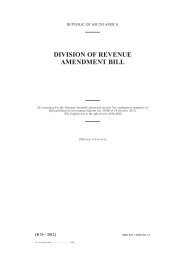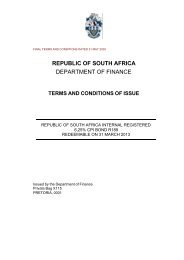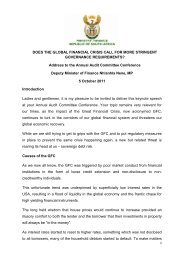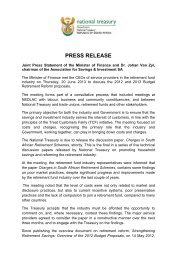1998 SOUTHERN AFRICA ECONOMIC ... - National Treasury
1998 SOUTHERN AFRICA ECONOMIC ... - National Treasury
1998 SOUTHERN AFRICA ECONOMIC ... - National Treasury
Create successful ePaper yourself
Turn your PDF publications into a flip-book with our unique Google optimized e-Paper software.
Z I M BA BW E<br />
Z i m b a b we Stock Exchange (ZSE)<br />
Y E A R 1 9 9 3 1 9 9 4 1 9 9 5 1 9 9 6 1 9 9 7<br />
Number of listed companies 6 3 6 5 6 5 6 5 6 7<br />
M a r ket cap i t a l i s a t i o n ,U S D m 1 , 430 . 4 1 , 679 . 0 2 , 105 . 0 4 , 830 . 4 2 , 283 . 7<br />
Number of companies making issues 4 12 1 6 9<br />
(including new, rights and bonus issues)<br />
Value of new issues incl. rights issues, 46 . 0 96 . 4 1 . 6 62 . 4 129 . 6<br />
U S D m<br />
Volume of shares traded, million 2 7 2 . 3 4 5 0 . 8 4 3 1 . 2 7 2 2 . 7 1 , 1 9 7 . 2<br />
Value of shares traded, U S D m 5 3 . 6 1 7 7 . 4 1 5 0 . 0 2 5 7 . 5 3 5 0 . 7<br />
Number of trading day s 253 252 250 253 251<br />
Average price-earning ratio of all 8.8 8.3 7.4 14.6 9.6<br />
listed companies, %<br />
Average dividend yield (annual 3.6 5.0 5.2 2.9 4.4<br />
ave r a g e ),%<br />
S o u rc e :Z i m b a b we Stock Exchange (<strong>1998</strong>).<br />
Fo reign Tr a d e<br />
About one-third of Zimbabwe ’s exports are destined fo r<br />
regional markets comprising SADC countries, South Africa in<br />
p a rt i c u l a r, and countries that are members of COMESA. T h e<br />
remaining share is divided equally between the European Union<br />
and the rest of the wo r l d . The pattern is re l a t i ve ly similar fo r<br />
i m p o rts to Zimbabwe, with some 48 percent originating fro m<br />
the re g i o n .<br />
Principal exports include unprocessed tobacco, fe rro - a l l oy s ,<br />
go l d ,n i c ke l ,cotton lint, m a nufactural products and hort i c u l t u r a l<br />
p ro d u c t s . Deliberate effo rts are being made to encourage<br />
higher value-added pro d u c t s . Main import goods are :m a c h i n e ry<br />
and transport equipment, m a nu f a c t u red go o d s , chemicals and<br />
f u e l .<br />
Tr a d e Li b e r a l i s a t i o n<br />
Trade regulations have been liberalised substantially during the<br />
1 9 9 0 s . I m p o rt and export formalities and border pro c e d u re s<br />
for road motor transport have also improved in recent times.<br />
E x p o rt licences are still re q u i red for certain strategic go o d s<br />
such as minerals, p e t ro l e u m , wild animals, basic agricultural<br />
commodities (including maize, c h e e s e, citrus fruits). On the<br />
n e g a t i ve list for imports are mainly goods that are restricted due<br />
to health and security re a s o n s ,as well as non-monetary go l d ,<br />
p recious and semi-precious stones.<br />
P r i v a t i s a t i o n<br />
Momentum in privatising state assets in Zimbabwe should be<br />
seen within the context of the broader Economic Refo r m<br />
S t r a t e g i e s ,and its two fold objective of retiring government debt,<br />
and to serve as a mechanism for black empowerment .<br />
An Inter-ministerial Committee of Ministers and Officials on<br />
C o m m e rcialisation and Privatisation has been constituted to<br />
e n s u re that the process is accomplished efficiently and is bro a d ly<br />
re p re s e n t a t i ve. F u n c t i o n a l ly, the Committee deliberates on<br />
p roposals submitted to it by line Ministries, and its decisions are<br />
sent to Cabinet for ap p rov a l . Of the 34 submissions made, a n<br />
estimated 44 percent has thus far re c e i ved ap p rov a l . To date<br />
about 52 state-owned enterprises have been earmarked fo r<br />
re s t r u c t u r i n g .In order to execute its duties effe c t i ve ly, t h e<br />
Committee has drafted a set of guidelines to assist it in<br />
evaluating each proposal on its merit. The guidelines are ;<br />
• that corporations deemed to be of strategic importance will<br />
not be privatised, but will be run on pure ly commercial basis,<br />
• that assets with aesthetic and social value (such as mu s e u m s )<br />
will not qualify for any form of restructuring whatsoeve r, a n d<br />
l a s t ly<br />
• that businesses run on commercial principles will be liable fo r<br />
outright sale.<br />
Thus far, t h ree prev i o u s ly gove r n m e n t - owned enterprises are<br />
n ow listed on the local stock exchange fo l l owing successful<br />
p r i v a t i s a t i o n . These are Dairibord , Cottcoand and the<br />
C o m m e rcial Bank.<br />
A Communications Bill is curre n t ly being drafted, t h e<br />
consequence of which should culminate in the clarification of<br />
government policy on the restructuring of the Zimbabwe Po s t s<br />
and Te l e c o m munications Corporation into a holding company<br />
managing four subsidiaries with responsibilities in the fo l l ow i n g<br />
a re a s ; postal serv i c e s , t e l e c o m mu n i c a t i o n s ,m a nufacturing of<br />
equipment and cellular network serv i c e s . The process is<br />
u n d e rt a ken in conjunction with the World Bank.<br />
Fo reign Di rect Inve s t m e n t<br />
The liberalisation of the investment climate in Zimbabwe has<br />
had a positive effect on the economy. The number of fo re i g n<br />
d i rect investments (FDIs) ap p roved by the Zimbabwe<br />
I nvestment Centre (ZIC) has increased from USD291.3m in<br />
1993 to USD648.9m in 1997. F i g u res provided by the ZIC show<br />
a re a s o n a b ly high and consistent rate of implementation of<br />
these pro j e c t s ,h overing around 55%.<br />
The sizeable BHP-Hart l ey Platinum investment projects valued<br />
at USD400m is expected to commence full operation this ye a r.<br />
A l s o, t h e re are plans by Anglo Zimbabwe to undert a ke a<br />
p l a t i num project in the region of USD70m which should see<br />
Z i m b a b we as the third largest platinum producer in the wo r l d ,<br />
with annual production of over a million tons.<br />
S e c t o r a l ly, the main beneficiaries have been commerc i a l ,m i n i n g<br />
and manufacturing sectors.<br />
The commercial sector increased its share of ap p roved pro j e c t s<br />
to about 60% (USD389.3m) in 1997 compared with 48%<br />
(USD459.7m) the previous ye a r. Both the mining and the<br />
m a nufacturing sectors have shown a fluctuating tre n d , w i t h<br />
1 9 9 4 ,and 1996 and 1997 re s p e c t i ve ly, s h owing strong intere s t .<br />
In terms of origin, most investment came from the deve l o p e d<br />
countries (USA,C a n a d a ,A u s t r a l i a ,e t c ) ,fo l l owed by Africa (South<br />
Africa and Mauritius) and Asia (China). Contributions fro m<br />
E u rope are negligible.<br />
105



